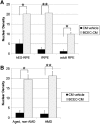Concise Review: Update on Retinal Pigment Epithelium Transplantation for Age-Related Macular Degeneration
- PMID: 30748126
- PMCID: PMC6477002
- DOI: 10.1002/sctm.18-0282
Concise Review: Update on Retinal Pigment Epithelium Transplantation for Age-Related Macular Degeneration
Abstract
Retinal cell therapy can have the objectives of rescue (i.e., modulation of metabolic abnormalities primarily for sight preservation) as well as replacement (i.e., replace cells lost due to injury or disease for sight restoration as well as preservation). The first clinical trials of retinal pigment epithelium (RPE) transplantation for vision-threatening complications of age-related macular degeneration (AMD) have begun with some preliminary signs of success (e.g., improvement in vision in some patients, anatomic evidence of transplant-host integration with some evidence of host photoreceptor recovery, long-term survival of autologous induced pluripotent stem cell-derived RPE transplants without immune suppression) as well as limitations (e.g., limited RPE suspension survival in the AMD eye, limited tolerance for long-term systemic immune suppression in elderly patients, suggestion of uncontrolled cell proliferation in the vitreous cavity). RPE survival on aged and AMD Bruch's membrane can be improved with chemical treatment, which may enhance the efficacy of RPE suspension transplants in AMD patients. Retinal detachment, currently used to deliver transplanted RPE cells to the subretinal space, induces disjunction of the first synapse in the visual pathway: the photoreceptor-bipolar synapse. This synaptic change occurs even in areas of attached retina near the locus of detachment. Synaptic disjunction and photoreceptor apoptosis associated with retinal detachment can be reduced with Rho kinase inhibitors. Addition of Rho kinase inhibitors may improve retinal function and photoreceptor survival after subretinal delivery of cells either in suspension or on scaffolds.
Keywords: Autologous stem cell transplantation; Cell transplantation; Clinical trials; Embryonic stem cells; Experimental models; Induced pluripotent stem cells; Retina.
© 2019 The Authors. Stem Cells Translational Medicine published by Wiley Periodicals, Inc. on behalf of AlphaMed Press.
Conflict of interest statement
Dr. Zarbin is a paid consultant for Cell Cure, Chengdu Kanghong Biotechnology Co., Coherus Biosciences, Inc., Daiichi Sankyo, Frequency Therapeutics, Genentech/Roche, Healios KK, Inc., Iridex, Isarna Therapeutics, Makindus, Novartis Pharma AG, Ophthotech Corp., and Percept Corp. Work on improving RPE survival on AMD Bruch's membrane is covered in U.S. Patent no. 9598672, issued March 21, 2017 (“Production of extracellular matrix, conditioned media and uses thereof.” Inventors: Sugino I (Madison, NJ), Zarbin, M. (Chatham, NJ), Sun Q. (West Orange, NJ), Birge R. (New York, NY). The other authors indicated no potential conflicts of interest.
Figures





References
-
- Wong WL, Su X, Li X et al. Global prevalence of age‐related macular degeneration and disease burden projection for 2020 and 2040: A systematic review and meta‐analysis. Lancet Glob Health 2014;2:e106–e116. - PubMed
-
- Zarbin MA. Current concepts in the pathogenesis of age‐related macular degeneration. Arch Ophthalmol 2004;122:598–614. - PubMed
-
- Green WR, Enger C. Age‐related macular degeneration histopathologic studies. The 1992 Lorenz E. Zimmerman Lecture. Ophthalmology 1993;100:1519–1535. - PubMed
Publication types
MeSH terms
Grants and funding
LinkOut - more resources
Full Text Sources
Other Literature Sources
Medical

